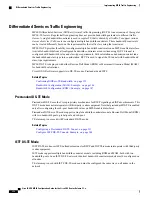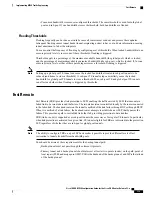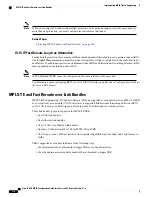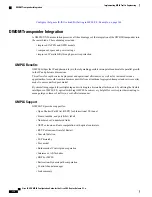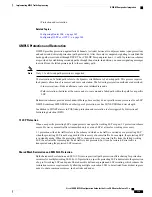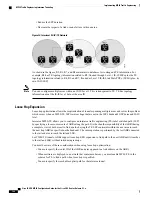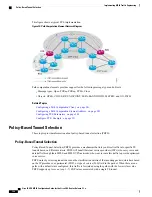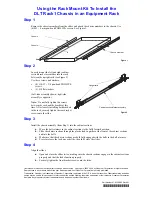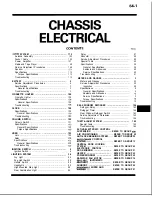
Loose Hop Reoptimization
Loose hop reoptimization allows the reoptimization of the tunnels spanning multiple areas and solves the
problem which occurs when an MPLS-TE headend does not have visibility into other IGP areas.
Whenever the headend attempts to reoptimize a tunnel, it tries to find a better path to the ABR in the headend
area. If a better path is found then the headend initiates the setup of a new LSP. In case a suitable path is not
found in the headend area, the headend initiates a querying message. The purpose of this message is to query
the ABRs in the areas other than the headend area to check if there exist any better paths in those areas. The
purpose of this message is to query the ABRs in the areas other than the headend area, to check if a better
path exists. If a better path does not exist, ABR forwards the query to the next router downstream. Alternatively,
if better path is found, ABR responds with a special Path Error to the headend to indicate the existence of a
better path outside the headend area. Upon receiving the Path Error that indicates the existence of a better
path, the headend router initiates the reoptimization.
ABR Node Protection
Because one IGP area does not have visibility into another IGP area, it is not possible to assign backup to
protect ABR node. To overcome this problem, node ID sub-object is added into the record route object of the
primary tunnel so that at a PLR node, backup destination address can be checked against primary tunnel
record-route object and assign a backup tunnel.
Fast Reroute Node Protection
If a link failure occurs within an area, the upstream router directly connected to the failed link generates an
RSVP path error message to the headend. As a response to the message, the headend sends an RSVP path
tear message and the corresponding path option is marked as invalid for a specified period and the next
path-option (if any) is evaluated.
To retry the ABR immediately, a second path option (identical to the first one) should be configured.
Alternatively, the retry period (path-option hold-down, 2 minutes by default) can be tuned to achieve a faster
retry.
Related Topics
Protecting MPLS Tunnels with Fast Reroute, on page 220
MPLS-TE Forwarding Adjacency
The MPLS-TE Forwarding Adjacency feature allows a network administrator to handle a traffic engineering,
label-switched path (LSP) tunnel as a link in an Interior Gateway Protocol (IGP) network based on the Shortest
Path First (SPF) algorithm. A forwarding adjacency can be created between routers regardless of their location
in the network.
MPLS-TE Forwarding Adjacency Benefits
TE tunnel interfaces are advertised in the IGP network just like any other links. Routers can then use these
advertisements in their IGPs to compute the SPF even if they are not the head end of any TE tunnels.
Cisco IOS XR MPLS Configuration Guide for the Cisco CRS Router, Release 5.1.x
183
Implementing MPLS Traffic Engineering
MPLS-TE Forwarding Adjacency




